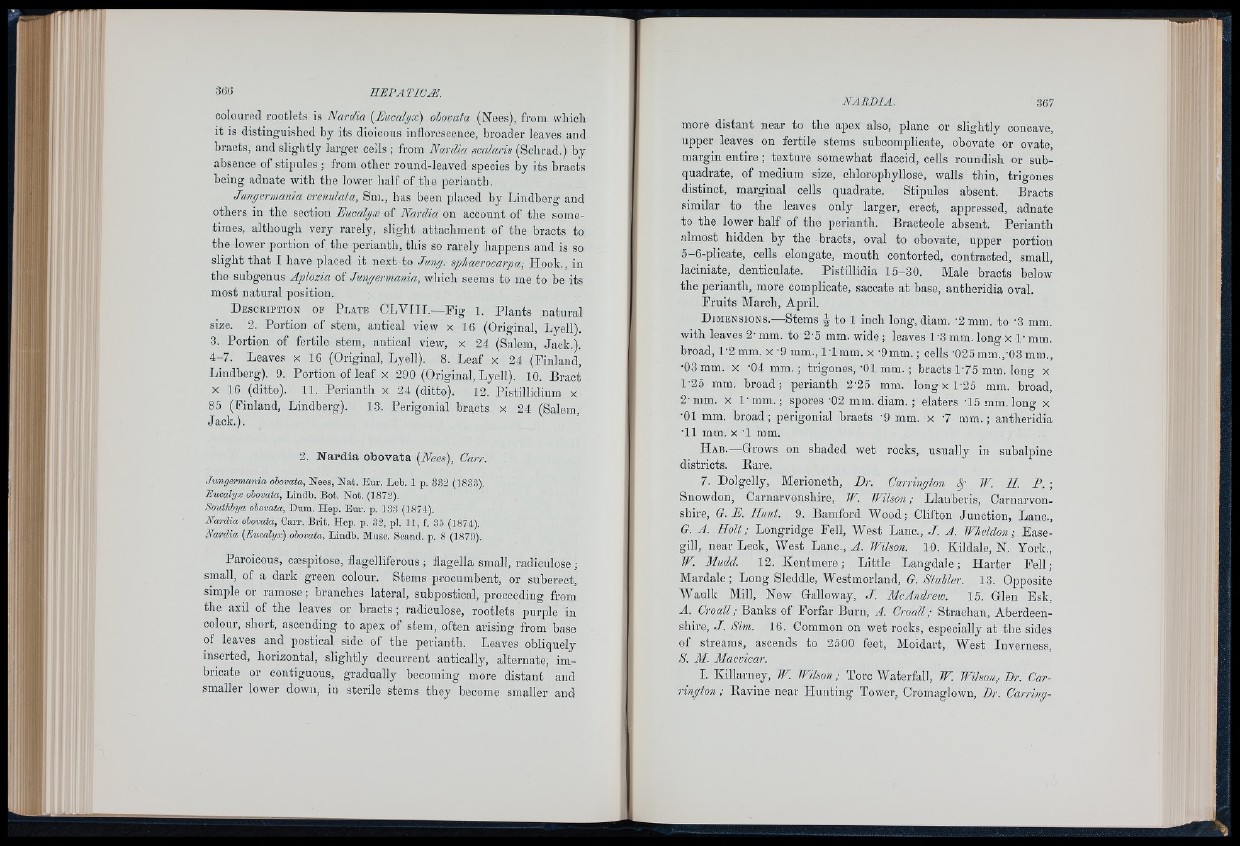
coloured rootlets is Nardia (Encalyx) obovata (Nees), from which
it is distinguished by its dioicous inflorescence, broader leaves and
bracts, and slightly larger cells ; from Nardia scalaris (Sohrad.) by
absence of stipules ; from other round-leaved species by its bracts
being adnate with the lower lialf of tbe perianth.
Jimgermania crenulata, Sm., lias been placed by Lindberg and
otliers in the section Eucalyx of Nardia on account of the sometimes,
although very rarely, sliglit attachment of the bracts to
the lower portion of the perianth, this so rarely happens and is so
slight that I have placed it ne.xt to Jung, sphaerocarpa. Hook., in
the subgenus Aplozia of Jungermania, which seems to me to be its
most natural position.
D escription op P late CLVIII.—Fig 1. Plants natural
size. 2. Portion of stem, antioal view x 16 (Original, Lyell).
3. Portion of fertile stem, antical view, x 24 (Salem, Jack.).
4-7. Leaves x 16 (Original. Lyell). 8. Leaf x 24 (Finland,
Lindberg). 9. Portion of leaf x 290 (Original, Lyell). 10. Braot
X 16 (ditto). 11. Perianth x 24 (ditto). 12. Pistillidium x
85 (Finland, Lindberg). 13. Perigonial bracts x 24 (Salem,
Jack.).
2. Nardia obovata (Nees), Carr.
Jungermania obovata, Nees, N a t. Eur. Leb. 1 p. 332 (1838).
Eucalyx obovata, Lindb. Bot. Not. (1872).
Southbya obovata, Dum. Hep. Bur. p. 133 (1874).
Nardia obovata, Carr. Brit. Hep. p. 32, pi. 11, f. 3o (1874).
Nardia (Eucalyx) obovata, Lindb. Muse. Scand. p. 8 (1879).
Paroicous, cæspitose, flagelliferous ; flagella small, radiculose ;
small, of a dark green colour. Stems procumbent, or suberect,
simple or ramose ; branohes lateral, subpostioal, proceeding from
the axil of the leaves or bracts ; radiculose, rootlets purple in
colour, short, ascending to apex of stem, often arising from base
of leaves and postical side of the perianth. Leaves obliquely
inserted, liorizontal, slightly decurrent antioally, alternate, imbrioate
or contiguous, gradually becoming more distant and
smaller lower down, in sterile stems they become smaller and
more distant near to the apex also, plane or slightly concave,
upper leaves on fertile stems subcomplioate, obovate or ovate,
margin entire ; texture somewhat flaccid, cells roundish or subquadrate,
of medium size, chlorophyllose, walls thin, trigones
distinct, marginal cells quadrate. Stipules absent. Bracts
similar to the leaves only larger, erect, appressed, adnate
to the lower half of the perianth. Bracteole absent. Perianth
almost hidden by the bracts, oval to obovate, upper portion
5-6-plicate, cells elongate, mouth contorted, contracted, small,
laciniate, denticulate. Pistillidia 15-30. Male bracts below
the perianth, more complicate, saccate at base, antheridia oval.
Pruits March, April.
D imensions.—Stems J to 1 inch long, diam. '2 mm. to A mm.
with leaves 2' mm. to 2'5 mm. wide; leaves 1A mm. long x 1- mm.
broad, 1'2 mm. x '9 mm., ITram. x Amm.; cells '025 mm..AS mm.,
•08 mm. X -04 mm.; trigones, -01 mm.; bracts 1-75 mm. long x
1-25 mm. broad; perianth 2-25 mm. long x 1-25 mra. broad,
2-mm. X 1-mm.; spores-02 mm. diam. ; elaters -15 mm, long x
•01 mm. broad; perigonial bracts -9 mm. x 7 mm.; antheridia
•11 mm. X -1 mm.
H a b .—Grows on shaded wet rocks, usually in subalpine
districts. Eare.
7. Dolgelly, Merioneth, Dr. Carrington fl IF. I I P. ;
Snowdon, Carnarvonshire, IF. Wilson; Llanberis, Carnarvonshire,
G.E. Hunt. 9. Bamford Wood; Clifton Junction, Lane.,
G. A. Holt: Longridge Fell, West Lane., J. A. Wheldon; Ease-
gill, near Leek, West Lane., A. Wilson. 10. Kildale, N. York.,
W. Mudd. 12. Kentmere; Little Langdale; Harter Fell;
Mardale; Long SleJdle, Westmorland, G. Stabler. 13. Opposite
Waulk Mill, New Galloway, J. McAndreio. 15. Glen Esk,
A. Croall; Banks of Forfar Burn, A. Croall; Strachan, Aberdeenshire,
J. Sim. 16. Common on wet rocks, especially at the sides
of streams, ascends to 2500 feet, Moidart, West Inverness,
S. M. Macvicar.
I. Killarney, W. Wilson ; Tore Waterfell, W. Wilson,. Dr. Carrington
Eavine near Hunting Tower, Cromaglown, Dr. Carring